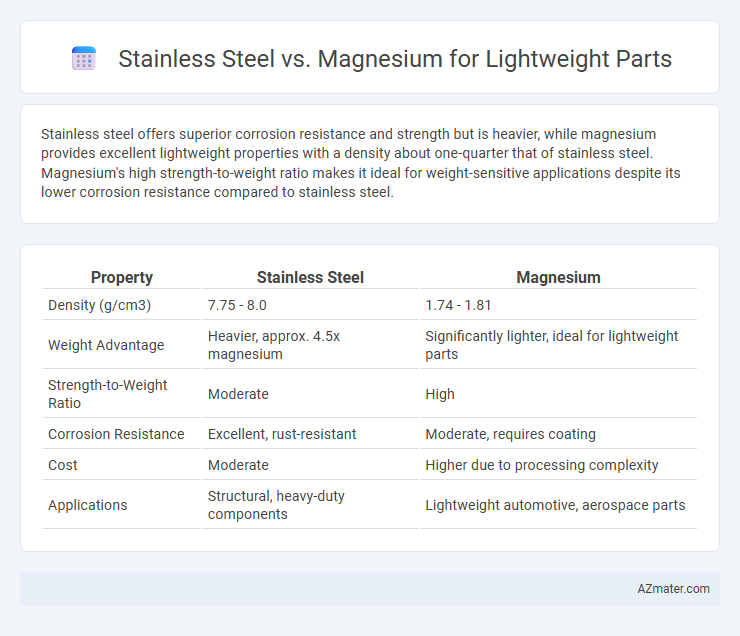Stainless steel offers superior corrosion resistance and strength but is heavier, while magnesium provides excellent lightweight properties with a density about one-quarter that of stainless steel. Magnesium's high strength-to-weight ratio makes it ideal for weight-sensitive applications despite its lower corrosion resistance compared to stainless steel.
Table of Comparison
| Property | Stainless Steel | Magnesium |
|---|---|---|
| Density (g/cm3) | 7.75 - 8.0 | 1.74 - 1.81 |
| Weight Advantage | Heavier, approx. 4.5x magnesium | Significantly lighter, ideal for lightweight parts |
| Strength-to-Weight Ratio | Moderate | High |
| Corrosion Resistance | Excellent, rust-resistant | Moderate, requires coating |
| Cost | Moderate | Higher due to processing complexity |
| Applications | Structural, heavy-duty components | Lightweight automotive, aerospace parts |
Introduction to Lightweight Materials in Engineering
Stainless steel offers high strength and corrosion resistance but has a higher density compared to magnesium, impacting overall weight in engineering applications. Magnesium, one of the lightest structural metals, provides excellent weight reduction with good mechanical properties but requires protective coatings to prevent corrosion. Selecting between stainless steel and magnesium involves balancing strength, weight, durability, and cost considerations for optimal lightweight part design.
Overview of Stainless Steel as a Lightweight Option
Stainless steel offers a high strength-to-weight ratio, making it a viable lightweight option compared to traditional metals despite being denser than magnesium. Its excellent corrosion resistance and durability enhance the lifespan of lightweight components in automotive and aerospace applications. Advances in alloy composition and manufacturing techniques continue to improve stainless steel's weight efficiency without compromising structural integrity.
Properties of Magnesium in Lightweight Applications
Magnesium exhibits exceptional properties for lightweight applications, including a density of approximately 1.74 g/cm3, which is about 33% lighter than aluminum and significantly less than stainless steel, typically around 8 g/cm3. Its high strength-to-weight ratio and excellent machinability make it ideal for aerospace, automotive, and electronics industries where weight reduction is critical. Moreover, magnesium's good damping capacity and thermal conductivity improve component performance and durability in dynamic and high-temperature environments.
Mechanical Strength: Stainless Steel vs Magnesium
Stainless steel offers significantly higher mechanical strength compared to magnesium, with tensile strength typically ranging from 400 to 1,200 MPa, whereas magnesium alloys generally exhibit tensile strengths between 150 and 350 MPa. Magnesium's lower density around 1.74 g/cm3 enables lightweight applications, but its reduced strength limits load-bearing capacity relative to stainless steel, which has a density of about 8.0 g/cm3. Engineering choices prioritize stainless steel for durability and impact resistance, while magnesium is selected for weight-sensitive parts requiring moderate mechanical strength.
Corrosion Resistance: Comparative Analysis
Stainless steel offers superior corrosion resistance due to its chromium content forming a passive oxide layer that prevents rust and degradation in various environments. Magnesium, while significantly lighter, is more susceptible to corrosion, especially in saline or humid conditions, unless treated with protective coatings or alloys. Choosing stainless steel provides enhanced durability against corrosion, whereas magnesium requires additional measures to achieve similar resistance in lightweight applications.
Weight and Density Considerations
Stainless steel has a density of approximately 8,000 kg/m3, making it significantly heavier than magnesium, which has a density around 1,740 kg/m3. For lightweight part applications, magnesium's lower density provides a substantial weight reduction, enhancing fuel efficiency and performance in aerospace and automotive industries. Despite its weight advantage, magnesium's mechanical properties and corrosion resistance must be balanced against stainless steel's durability for optimal material selection.
Cost Effectiveness and Market Availability
Stainless steel offers high corrosion resistance and durability but is generally heavier and more expensive than magnesium, impacting its cost-effectiveness for lightweight parts. Magnesium provides superior weight reduction and competitive pricing due to its abundance and ease of casting, making it a preferred choice in automotive and aerospace sectors. Market availability favors stainless steel for widespread industrial use, while magnesium's niche applications are expanding with advances in alloy technology and supply chain improvements.
Manufacturing and Fabrication Differences
Stainless steel offers high strength and corrosion resistance, making it ideal for parts requiring durability but involves energy-intensive manufacturing and slower machining processes due to its hardness. Magnesium, significantly lighter with excellent strength-to-weight ratio, allows faster machining and easier casting but requires protective coatings to prevent corrosion and careful handling due to its flammability during fabrication. The choice between stainless steel and magnesium depends on balancing manufacturing complexity, corrosion management, and weight reduction targets in lightweight part production.
Application-Specific Suitability
Stainless steel offers exceptional corrosion resistance and strength, making it ideal for applications requiring durability in harsh environments, such as automotive exhausts and chemical processing equipment. Magnesium's low density and high strength-to-weight ratio suit aerospace and portable electronics where weight reduction is critical without sacrificing structural integrity. Selecting between these metals depends on prioritizing resistance and longevity with stainless steel or minimizing weight while maintaining adequate strength with magnesium.
Conclusion: Choosing the Right Material for Lightweight Parts
Stainless steel offers superior strength, corrosion resistance, and durability, making it ideal for applications requiring robustness despite its heavier weight. Magnesium provides excellent lightweight properties with a density approximately 33% that of aluminum, enabling significant weight reduction but with lower strength and corrosion resistance. Selecting between stainless steel and magnesium depends on the balance between weight savings and mechanical performance, where magnesium is favored for extreme lightness and stainless steel for structural integrity and longevity.

Infographic: Stainless steel vs Magnesium for Lightweight part
 azmater.com
azmater.com